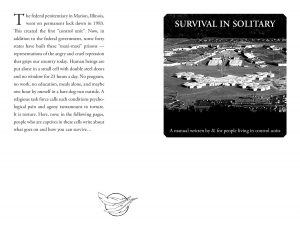
“Since the early 1990s, increases in the prison population in England and Wales have sparked a boom in prison construction, leading commentators to comment on ‘the largest prison building program since the middle of the 19th century’ (Morgan, 1999: 110). While women make up a small proportion of those incarcerated, their rates of imprisonment have multiplied faster than men’s, causing feminist activists to call for drastic measures to counter ‘the crisis in women’s prisons’. 4 Between 1985 and 1998, for example, the number of women in prison more than doubled, from 1,532 to 3,260 (Prison Reform Trust, 2000). The prison service has responded by contracting with private corporations to built and operate new prisons, and by rerolling men’s prisons for women. Recent government initiatives designed to slow the increase in the use of incarceration, such as Home Detention Curfews, have had little impact on the number of women sentenced to prison which continued to grow during the year to 2001 by 9%, compared to 2% for men.”
- 1960s
- A. Morefus
- ableism
- abuse
- ACAB
- accountability process
- A Conspiracy to Arm Self-Care
- activity
- addiction
- adventure
- Affan Kurniawan
- affinity
- affinity group
- affinity groups
- africa
- Alberta Thompson
- alcoholism
- Alex Gorrion
- ALF
- alfredo m. bonanno
- ally industrial complex
- ally politics
- allyship
- Almeria
- anarcha-feminism
- anarchism
- Anarchism and the Black Revolution
- anarchist
- anarchist-nihilism
- Anarchists Against The Wall
- anarcho-nihilism
- anarcho-pessimism
- anarcho-primitivism
- anarchy
- anarquismo
- anarquista
- anarquía
- animal liberation
- animal liberation brigade
- Animal Liberation Front
- animal rights
- animal rights militia
- An Invitation to Desertion
- Anna Beniamino
- anthropocentrism
- anthropology
- anti-ally politics
- anti-anthropocentrism
- Anti-Apartheid
- anti-capitalism
- anti-capitalista
- anti-civ
- anti-civilization
- anti-civ vegan
- anti-colonialism
- anti-colonization
- anti-cop
- anti-essentialism
- anti-fascism
- anti-fascist
- anti-gentrification
- anti-homophobia
- anti-hunting
- anti-identity
- anti- identity politics
- anti-left
- anti-left anarchy
- anti-medical
- anti-medication
- anti-natalism
- anti-nationalism
- anti-oppression
- anti-patriarchy
- anti-police
- anti-politics
- anti-psychiatry
- anti-racism
- anti-racist
- anti-racist action
- anti-religion
- anti-school
- anti-science
- anti-sexism
- anti-slavery
- anti-speciesism
- anti-speciesist
- Anti-State STL
- anti-statism
- anti-tech
- anti-technology
- anti-tiqqun
- anti-voting
- anti-work
- anti-workerism
- antifa
- ARA
- Aragorn!
- Archegonos
- Armeanio Lewis
- armed self-defense
- armed struggle
- Artificial Intelligence
- ashanti alston
- assassination
- asylum riots
- athens
- Attack
- Audio Anarchy Radio
- autonomous zone
- autonomy
- Baba Yaga
- Backwoods A journal of anarchy and wortcunning
- baeden
- Bands of Mercy
- Bandung
- banner drops
- BASH BACK! Queer Ultraviolence
- Bellamy Fitzpatrick
- Beyond Negativity: What Comes After Gender Nihilism
- Biblioteca Antiespecista R-209
- Billy-Ray Belcourt
- biocentrism
- black anarchism
- black anarchy
- black bloc
- black liberation
- black liberation army
- black panther party
- Blessed is the Flame
- bobby whittenberg-james
- Boles
- Brenda Peterson
- call-out culture
- canada
- cancel culture
- Castanea Dentata
- CCF
- cells
- chaos
- chile
- Chiron band
- christianity
- cigarettes
- Civ Fucks Distro
- class struggle
- class war vegan
- Claustrofobia Ediciones
- collectives
- communalism
- commune
- communique
- communiques
- communisation theory
- communism
- community
- communization
- communization theory
- concentration camp rebellion
- consent
- consent culture
- Conspiracy Cells of Fire
- conspiracy of cells of fire
- consumerism
- cooking
- Craig Womack
- Crimethinc
- crust punks
- cultural appropriation
- cultural essentialism
- Culture
- Dangerous Spaces
- decolonial
- decolonization
- deep ecology
- defend the atlanta forest
- democracy
- Denisa Krásná
- DESTROY
- detoxify da hood
- direct action
- direct democracy
- dirty kids
- disability
- DIY
- domestication
- domestic violence
- dreadlocks
- drugs
- Earth First!
- earth liberation
- Eccepunkarto
- eco-defense
- eco-feminism
- eco-pessimism
- ecología
- Edelweiss Pirates
- educational industrial complex
- egoism
- egoist anarchy
- egoist communism
- egoist vegan
- egosim
- El Borracho (Noöm ad Warfuk)
- emma goldman
- encryption
- Enemies of Society: An Anthology of Individualist and Egoist Thought
- environmentalism
- Enzo Martucci
- Español
- Especismo
- essentialism
- ethics
- Evasion
- ex-smokers
- existentialism
- F.A.A.F
- F.L.A
- FAI
- Farah Shah
- feminism
- feral edge
- feral faun
- firearms
- Flower Bomb
- food
- foraging
- Formal Anarchist Federation
- France
- free love
- freight hopping
- fuck you police
- fun
- Féminas Brujas and Insurrectionalists
- gardening
- gender
- gender abolition
- gender anarchy
- gender anarky
- gender nihilism
- Gender Nihilism: An Anti-Manifesto
- George Floyd
- George Jackson
- Gianluca Iacovacci
- globalization
- grand juries
- grand jury resisting
- greece
- green anarchism
- green anarchy
- guide
- guns
- hardcore
- health
- herbal
- herbalism
- herbs
- Here and Now Distro
- high school
- history
- hitchhiking
- Hunt Sab
- hunt sabotage
- HXC
- hygiene
- identity
- identity politics
- illegalism
- illegalist anarchy
- indigenious resistance
- indigenous
- indigenous anarchy
- indigenous egosim
- Indigenous Genocide
- Indigenous Resistance
- indigenous straight edge
- indigenous veganism
- individualism
- individualist
- individualist anarchy
- individualist vegan
- individulalist anarchy
- Indonesia
- industrial collapse
- industrial society
- Informal Anarchist Federation
- informal organization
- informal organizing
- inhabit
- innocence
- insurgency
- insurrection
- insurrection anarchy
- insurrectionary anarchy
- internet
- intersectionality
- intoxication culture
- introduction anarchy
- invisible committee
- Israeli Anarchists
- italian insurrectionists
- john zerzan
- Joyful Militancy
- judi bari
- justice department
- Kerry Redwood Ajecoutay
- Kirsty Dunn
- know your rights
- La Verda Planedo
- Layla AbdelRahim
- la zad
- leaderless resistance
- learning machines
- leftism
- Libcom
- liberación Animal
- liberalism
- liberal vegan
- lifestyle anarchism
- lifestyle anarchy
- lifestylism
- Linda Hogan
- Lint Lobotomy
- Little Mouse Fun
- lone wolf attack
- love
- Luca Nicos
- Makah Whale Hunt
- Malcolm X
- Mansour Yarow
- Margaret Robinson
- marriage
- Marti Kheel
- mass society
- Matilde Nuñez del Prado
- max stirner
- medication
- medicine
- mental health
- mexico
- Mi'kmaw
- michael kimble
- Michael Tabor
- Mikhail Zhlonitsky
- minneapolis
- morality
- morals
- Morgan Taylor
- MOVE
- Moxie Marlinspike
- mushrooms
- music
- Mónica Caballero
- Māori
- nanotechnology
- native american
- Netherlands
- new york city
- nihilism
- nihilist
- nihilist anarchy
- nihilist vegan
- no gods no masters
- nomadic
- non-violence
- occupy wall street
- online
- Onyx
- oogles
- open relationships
- pacific northwest
- pacifism
- Paul Z. Simons
- pesticides
- phantom cell
- pharmaceutical industrial complex
- plant-based kai
- play
- poetry
- political prisoner
- polyamory
- post-feminist anarchy
- post-left anarchism
- post-left anarchy
- post-left individualism
- post-leftism
- post-race anarchy
- power dynamics
- primitivism
- prison-industrial complex
- prison abolition
- prisoner solidarity
- prisoner support
- prison industrail complex
- prison solidarity
- privilege
- propaganda by the deed
- property destruction
- psychiatry
- psychology
- punk
- queer
- queer anarchy
- queer edge
- queer insurrection
- queer negativity
- queer nihilism
- r209.net
- Rabia Y Accion
- race
- race essentialism
- race nihilism
- radical sobriety
- radical vegan
- recipes
- relationship anarchy
- relationships
- Renzo Conners
- Renzo Connors
- Renzo Novatore
- revolutionary
- revolutionary cells
- rewilding
- Ria Del Montana
- rioting
- Riotous Incognitx
- Rita Laws
- Robert F. Williams
- runaway
- Russell Maroon
- Russian nihilism
- sabotage
- safe space
- safe spaces
- Samah Seger
- Scripta Manent
- Sea Shepard
- security
- security culture
- self-defense
- self-help
- self-organization
- self care
- Serafinski
- sexual assault
- sexuality
- SHAC
- Shane
- Sindre
- sleeper cell
- SLF
- smoking
- social justice
- Social War
- Solidarity with Palestine
- solitary confinement
- Soul Food
- spanish
- squatting
- Standard American Diet
- statism
- straight edge
- suicide
- survivors guide
- Susaron 4
- sxe
- SXE MADRID
- tactics
- techniology
- technological industrial complex
- technology
- tech tools
- teeth
- Thanksgiving
- The Bonnet Gang
- The Bonnot Gang
- the coming insurrection
- The Deacons for Defense
- The George Jackson Brigade
- The Local Kids
- the prison industrial complex
- the working man is a sucka
- Thomas S. Szasz
- Tinnitus Patches
- tiqqun
- total liberation
- train hopping
- transgender
- trans insurrection
- trans resistance
- transsexual
- traveling
- travellers
- uk
- Unoffensive Animal
- UPIT ANARCHY
- uprising
- Vega
- vegan
- vegan anarchy
- veganarchism
- veganarchy
- vegan egoist
- veganism
- veganismo
- vegan nihilism
- vegan primitivism
- vegetarianism
- Venita Januarie
- Venona Q.
- Vetriolo
- violence
- voting
- wage-slave
- warzone distro
- Wendy Syfret
- western medicine
- West Java
- white abolishion
- willful disobedience
- wimmin's fire brigade
- Wince Me Boi
- Windy Hart
- Winston Smith
- Winston “Boogie” Smith
- Wolfi Landstreicher
- woman's liberation
- women's liberation
- youth liberation
- Zero One Destruct
- Ziq
Celling Black Bodies: Black Women in the Global Prison Industrial Complex
Survival in Solitary: A manual written by & for people living in control units

Text from back cover:
“The federal penitentiary in Marion, Illinois, went on permanent lock down in 1983. This created the first “control unit”. Now, in addition to the federal government, some forty states have built these “maxi-maxi” prisons — representations of the angry and cruel repression that grips our country today. Human beings are put alone in a small cell with double steel doors and no window for 23 hours a day. No program, no work, no education, meals alone, and maybe one hour by oneself in a bare dog-run outside. A religious task force calls such conditions psychological pain and agony tantamount to torture. It is torture. Here, now, in the following pages, people who are captives in these cells write about what goes on and how you can survive…”